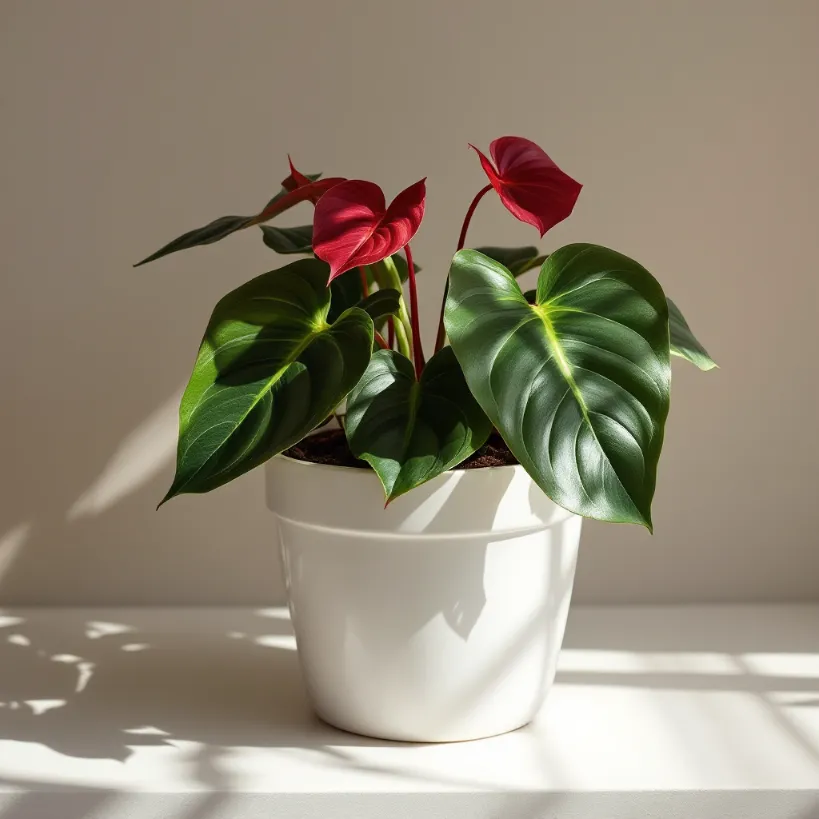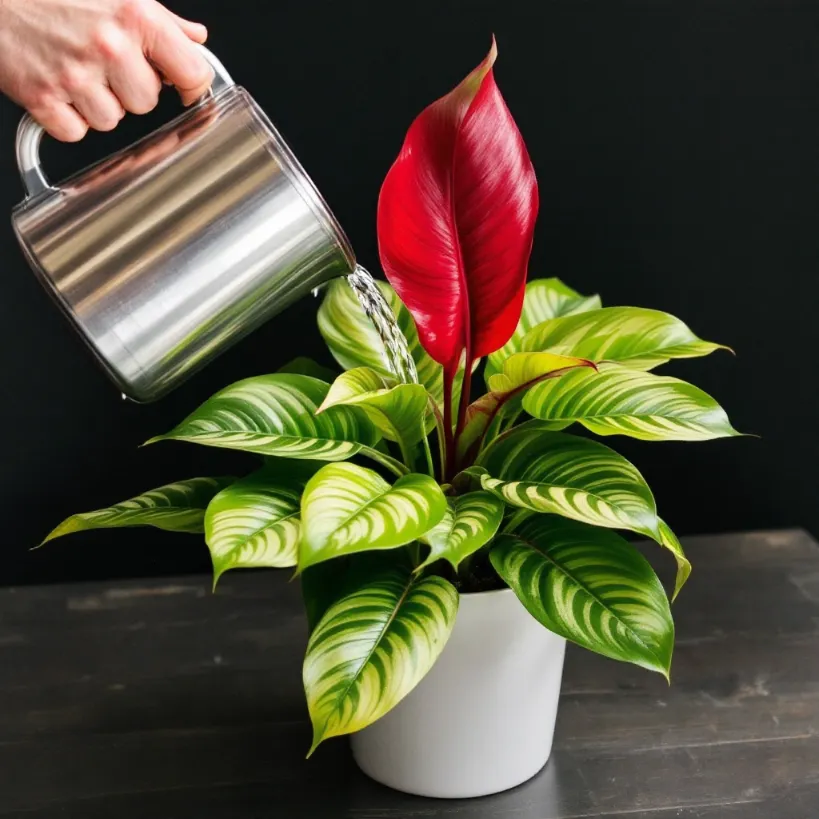The Philodendron Red Emerald sits in the corner of my room, red stems glowing like veins against the wall. It doesn’t ask for much — just some water, light, and the occasional nod of recognition. This hybrid beauty, with its heart-shaped leaves and crimson petioles, brings a touch of the wild into our sterile homes.
Taking care of it isn’t rocket science, but there are tricks to keeping it happy. The plant thrives in bright, indirect light and likes its soil moist but not soggy. Too much water and those gorgeous leaves will turn yellow. Too little and they’ll droop like a sad drunk at closing time.
Key Takeaways
- Water when the top inch of soil feels dry, typically every 1-2 weeks
- Place in bright, indirect light — direct sun burns the leaves
- Use well-draining soil with peat, perlite, and orchid bark
- Maintain humidity between 50-70% for optimal growth
- Feed with diluted balanced fertilizer every 4-6 weeks during growing season
- Propagate easily through stem cuttings with nodes placed in water
What Is a Philodendron Red Emerald?

The Philodendron Red Emerald isn’t just another pretty face in the houseplant crowd. It’s a hybrid stemming from Philodendron Erubescens, created by R.H. McColley at Bamboo Nursery in Florida. The plant stands out with its striking red stems and deep green, heart-shaped leaves that start off with a reddish tint when new.
This climbing aroid doesn’t just look good — it works for you too. It helps clean the air by removing pollutants like formaldehyde. The plant can grow quite tall with the right support, making it perfect for adding some vertical drama to your space.
Light Requirements
The Red Emerald isn’t picky about light, but it has preferences. It wants bright, indirect light — think dappled sunshine through tree branches. Too much direct sun will scorch those beautiful leaves, leaving brown patches that won’t heal. Too little light and the plant gets leggy, with long stems and tiny leaves.
If your home lacks natural light, don’t worry. This plant adapts to lower light conditions, though growth will slow down. For the deepest red stems, place it somewhere bright but protected from direct rays. A few feet from an east or west-facing window works well.
Watering Needs
Watering this plant is like dating — it’s all about finding the right balance. The Red Emerald likes its soil slightly moist but hates wet feet. Check the top inch of soil before watering. If it’s dry, it’s drinking time.
During summer, water once or twice weekly. In winter, cut back but don’t let it dry out completely. Use lukewarm water to avoid shocking the plant. And always make sure your pot has drainage holes — standing water leads to root rot faster than you can say “overwatered”.
Soil and Potting
The right soil makes all the difference for this plant. It wants a well-draining mix that holds some moisture without getting soggy. A blend of peat moss, perlite, and orchid bark works wonders. This mix gives roots room to breathe while holding enough water to keep them happy.
When potting, choose a container with drainage holes that’s just one size larger than the current one. Spring is the best time for repotting, as the plant enters its growth phase. If you notice roots peeking through drainage holes or growth slowing down, it’s time for a new home.
Humidity and Temperature
The Red Emerald comes from tropical forests, so it loves humidity. Aim for levels between 50-70%. If your home runs dry, mist the leaves occasionally or group plants together to create a mini humidity zone. For serious plant enthusiasts, check out our guide to houseplants for humid environments.
Temperature-wise, keep it above 18°C (65°F). This plant doesn’t handle cold well — it’s like me before coffee, sluggish and unresponsive. Avoid placing it near drafts, air conditioners, or heaters that create temperature swings.
Fertilizing
Feed your Red Emerald during the growing season (spring and summer) with a balanced liquid fertilizer diluted to half strength. Every 4-6 weeks is plenty. In fall and winter, cut back as growth slows.
Remember — more isn’t better with fertilizer. Too much can burn the roots and cause more harm than good. If you notice yellowing leaves after feeding, you might be overdoing it.
Propagation Methods
Creating new Red Emerald plants is surprisingly easy. The simplest method is stem cuttings. Look for a healthy stem with at least one node — those small brown bumps where leaves meet the stem. Cut just below the node with clean scissors.
You can root the cutting in water or directly in soil. If using water, add some horticultural charcoal to prevent rot, and change the water regularly. Once roots reach a couple of inches long, pot up in soil. Keep the new plant warm and humid while it establishes. For more detailed guidance, visit our comprehensive guide on philodendron propagation methods.
Common Problems and Solutions
Yellowing Leaves
Yellow leaves usually mean too much water. Check soil moisture and adjust your watering schedule. If the problem persists, consider repotting in fresh soil to give those roots a new start. Learn more about why philodendron leaves turn yellow.
Brown Tips or Edges
This typically signals low humidity or inconsistent watering. Increase humidity around the plant with misting or a humidifier, and stick to a regular watering schedule. For more insights, check our guide on why philodendrons have brown spots.
Pests
The Red Emerald isn’t particularly pest-prone, but it can attract mealybugs, spider mites, and aphids. Neem oil is your best defense — apply it at the first sign of trouble. Regular leaf cleaning helps prevent infestations before they start. For comprehensive solutions, see our article on philodendron plants pests and diseases.
Poor Growth
If your plant isn’t growing as expected, it might need more light or nutrients. Try moving it to a brighter spot or giving it a light feeding with fertilizer. For more troubleshooting tips, visit our guide on troubleshooting philodendron plants.
Is Philodendron Red Emerald Pet-Friendly?

Unfortunately, this beauty has a dark side. Like all philodendrons, the Red Emerald contains calcium oxalate crystals that are toxic to pets. If ingested, these crystals cause irritation in the mouth, throat, and stomach, leading to drooling, vomiting, and difficulty swallowing.
If you have curious pets, place your plant out of reach on high shelves or in hanging baskets. Alternatively, consider pet-friendly houseplants like spider plants, Boston ferns, or certain succulents.
Styling Your Philodendron Red Emerald
The Red Emerald makes a statement wherever you place it. Its climbing nature means it benefits from a support structure — a moss pole, trellis, or even a wall with plant clips works well. As it grows, the leaves become larger and more dramatic.
For a modern look, place it in a simple pot that complements your décor. The contrast between the red stems and green leaves works with most color schemes. Group it with plants of different textures for an eye-catching display. For more creative ideas, check out our houseplant styling tips.
Final Thoughts
The Philodendron Red Emerald isn’t just another houseplant — it’s a living sculpture that grows more impressive with time. With basic care and a little attention, it rewards you with stunning foliage and vertical interest. Even if you’ve killed every plant you’ve touched, this forgiving beauty might just break your curse. Just remember: bright indirect light, consistent moisture, and occasional feeding. The rest is just showing up and paying attention.
References:
- Plantastic Haven – Indoor Plant Basics
- Travaldo’s Blog – Philodendron Red Emerald Care
- The City Wild – Red Emerald Philodendron Care Guide
- Cafe Planta – The Scientific Name of Philodendron Red Emerald
- Greg App – 3 Tips for Growing Philodendron Red Emerald Indoors
- Cafe Planta – Are Philodendron Red Emeralds Pet Friendly?
- Plants Whizz – Red Emerald Philodendron Care